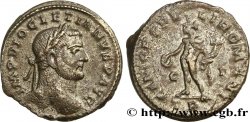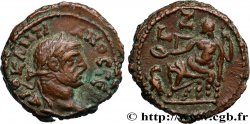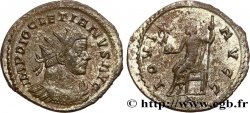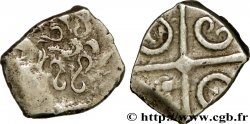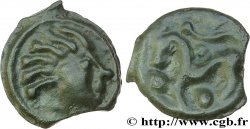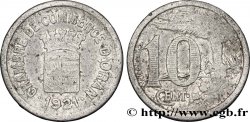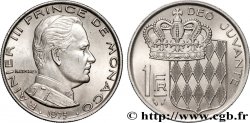v36_0758 - DIOCLETIANUS Aurelianus
MONNAIES 36 (2008)
Startpreis : 145.00 €
Schätzung : 500.00 €
unverkauftes Los
Startpreis : 145.00 €
Schätzung : 500.00 €
unverkauftes Los
Type : Aurelianus
Datum: 292
Name der Münzstätte / Stadt : Gaule, Lyon
Metall : Scheidemünze
Der Feingehalt beträgt : 50 ‰
Durchmesser : 23 mm
Stempelstellung : 6 h.
Gewicht : 3,97 g.
Seltenheitsgrad : R1
Officine: 1re
Emission: 8e
Kommentare zum Erhaltungszustand:
Exemplaire sur un flan bien centré avec les grènetis visibles. Très beau portrait. Revers de style fin, bien venu à la frappe. Magnifique patine grise avec des reflets métalliques
N° im Nachschlagewerk :
Vorderseite
Titulatur der Vorderseite IMP DIOCLETIANVS AVG.
Beschreibung Vorderseite Buste radié et cuirassé de Dioclétien à droite avec pan de paludamentum, vu de trois quarts en avant (B01).
Übersetzung der Vorderseite “Imperator Diocletianus Augustus”, (L’empereur Dioclétien auguste).
Rückseite
Titulatur der Rückseite IOVI - AVGG/ -|-// A.
Beschreibung Rückseite Jupiter nu jusqu'à la ceinture assis à gauche, tenant un globe nicéphore de la main droite et un sceptre long de la main gauche.
Übersetzung der Rückseite “Iovi Augustorum”, (Au Jupiter des augustes).
Kommentare
Rubans de type 3 aux extrémités bouletées. Cuirasse et épaulière cloutées. Ptéryges fines et tombantes. Sur cet exemplaire, sous la titulature de Dioclétien, nous semblons apercevoir le reste des lettres de la titulature de Maximien Hercule, en particulier le M sous le D et le X sous le C. Daniel Gricourt signalait déjà ce genre d’anomalie dans son article de la Revue Belge de Numismatique en 1984 et dans le Supplément II, op. cit, p. 78 “D’autres cas concernent la pertinence des titulatures et des effigies : parfois, le scalptor grave la titulature d’un empereur autour de l’effigie d’un autre des Tétrarques. Une titulature et un buste de Dioclétien peuvent ainsi être associés à une titulature de Maximien” (Gricourt, p. 68, n° 8). Cette variété ne semble pas avoir été signalée. Prendra le numéro 436g dans le Supplément III du Bastien.
Type 3 ribbons with rounded ends. Studded breastplate and shoulder guard. Thin, drooping pteryges. On this example, under the titulature of Diocletian, we seem to see the rest of the letters of the titulature of Maximian Hercules, in particular the M under the D and the X under the C. Daniel Gricourt already pointed out this type of anomaly in his article in the Revue Belge de Numismatique in 1984 and in Supplement II, op. cit, p. 78 “Other cases concern the relevance of titulatures and effigies: sometimes, the scalptor engraves the titulature of an emperor around the effigy of another of the Tetrarchs. A titulature and a bust of Diocletian can thus be associated with a titulature of Maximian” (Gricourt, p. 68, no. 8). This variety does not seem to have been reported. Will take number 436g in Supplement III of Bastien
Type 3 ribbons with rounded ends. Studded breastplate and shoulder guard. Thin, drooping pteryges. On this example, under the titulature of Diocletian, we seem to see the rest of the letters of the titulature of Maximian Hercules, in particular the M under the D and the X under the C. Daniel Gricourt already pointed out this type of anomaly in his article in the Revue Belge de Numismatique in 1984 and in Supplement II, op. cit, p. 78 “Other cases concern the relevance of titulatures and effigies: sometimes, the scalptor engraves the titulature of an emperor around the effigy of another of the Tetrarchs. A titulature and a bust of Diocletian can thus be associated with a titulature of Maximian” (Gricourt, p. 68, no. 8). This variety does not seem to have been reported. Will take number 436g in Supplement III of Bastien








 Berichten über einen Fehler
Berichten über einen Fehler Die Seite drucken
Die Seite drucken Teilen meiner Auswahl
Teilen meiner Auswahl Stellen Sie eine Frage
Stellen Sie eine Frage Einlieferung/Verkauf
Einlieferung/Verkauf
 Details
Details
